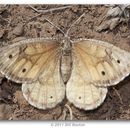The upperside is dull ochre-brown, with a variable number of small black eyespots, usually two on the forewing and one on the hindwing. The underside is finely striated black and white, with a distinct hindwing median band. The hindwing veins are outlined in white, unlike
O. uhleri. The nominate subspecies (described from the mouth of Fish Creek near Calgary) occurs throughout southern Alberta. The Peace River populations are a darker, unnamed subspecies (Bird et al. 1995).
cc-by-nc
direitos autorais
University of Alberta Museums

